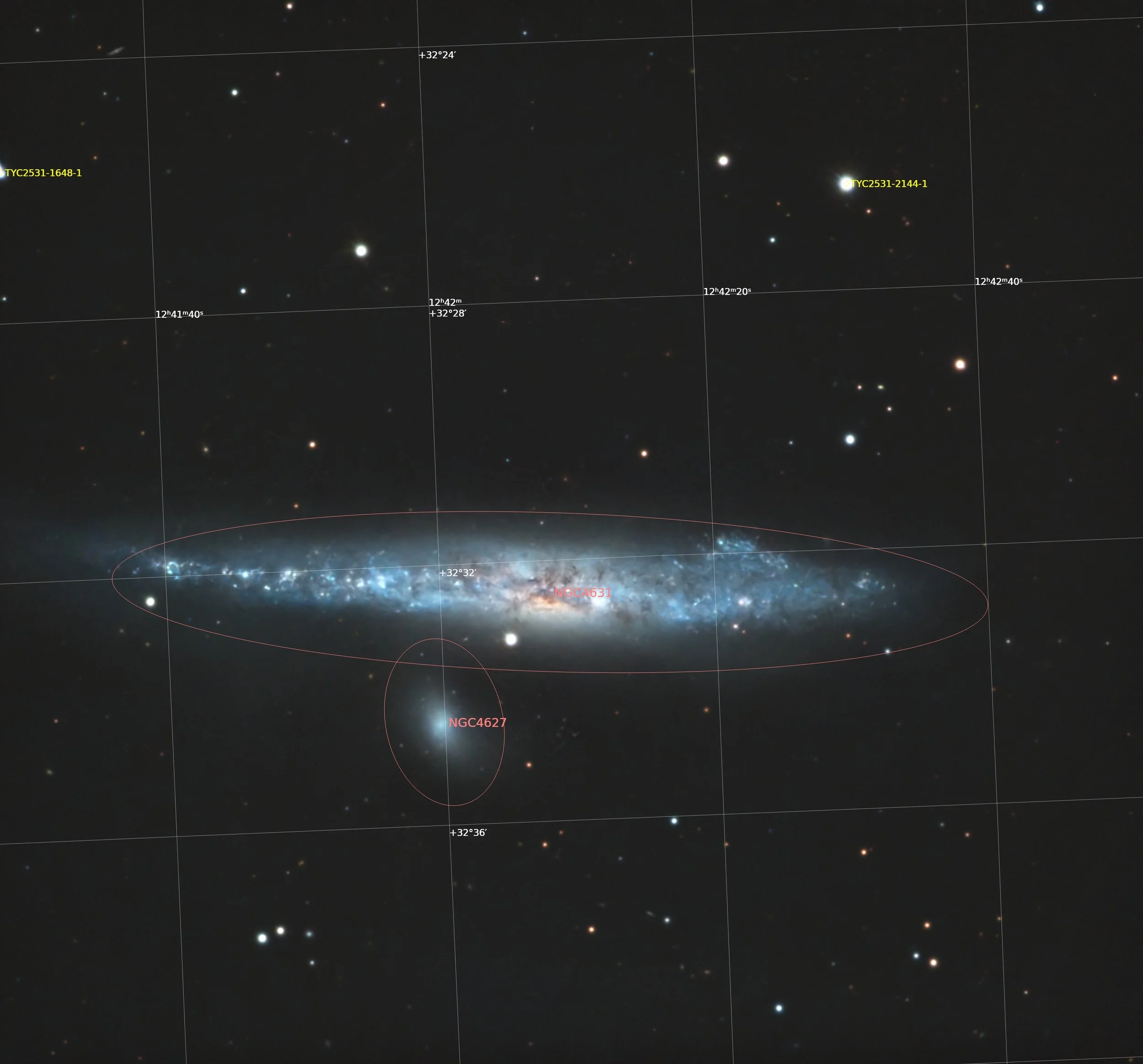NGC 4631 : The Whale Galaxy
The Whale Galaxy, also known as NGC 4631 (or Caldwell 32), is a stunning edge-on spiral galaxy located in the constellation Canes Venatici.
NGC 4631 was discovered by the German-British astronomer William Herschel in 1787
The velocity of NGC 4631 relative to the cosmic microwave background is 873 ± 18 km/s, corresponding to a Hubble distance of 12.9 ± 0.9 Mpc (∼42.1 million light-years).
NGC 4631 was used by Gérard de Vaucouleurs as a barred spiral galaxy in his galaxy atlas.
The Whale Galaxy (NGC 4631) isn't too difficult to find because it lies between two bright stars : Cor Caroli, the star in the Canes Venatici, and Denebola, at the tail of the Lion. Cor Caroli lies directly beneath Alkaid, the star at the tip of the Big Dipper's handle, and Denebola lies just east (left) of Sickle, the asterism that outlines the head and mane of the Lion. NGC 4631 lies about 6 degrees south of Cor Caroli, toward Denebola.
Observation Data
Constellation : Canes Venatici
Right Ascension (RA) : 12h 42m 08 s
Declination (Dec) : +32° 32′ 29″
Apparent Magnitude : ~9.8 (fairly bright in large amateur scopes)
Angular Size : 15.5′ × 2.7′ (long and thin)
Distance : ~25 million light-years (7.6 Mpc)
Galaxy Type : SB(s)d (barred spiral, edge-on)
Radial Velocity : ~610 km/s
Surface Brightness : ~13.5 mag/arcmin²
Appearance
Its elongated, slightly warped shape resembles a whale swimming through space.
X-ray Halo : The galaxy has a bright X-ray halo, likely caused by intense starburst activity driving hot gas into the galactic halo.
Interacting Group : NGC 4631 is part of a small group of galaxies and is interacting gravitationally with its companions, which contributes to its dynamic shape.
Three interacting galaxies
NGC 4627, NGC 4631, and NGC 4656 are gravitationally interacting with each other.
NGC 4631 and NGC 4656 also form a pair of gravitationally interacting galaxies.
NGC 4656 is about half a degree to the southeast and could be only half a million light-years away from NGC 4631, taking into account uncertainties in the two galaxies' distances.
According to Edwin L. Turner, NGC 4627 and NGC 4631 form a pair of close galaxies.
A study conducted in the mid-1970s revealed that a large amount of neutral hydrogen was detected at a distance of up to 12 kpc (39 000 light years) above the galactic plane, with a complex structure joining NGC 4631 and NGC 4656.
Images of NGC 4656 show giant tidal stream areas. The stream has two bridges extending between NGC 4631 and NGC 4656 as well as another area on the opposite side.
Together, these two components extend over 85 kpc.
However, the orientation of the southeast stream relative to the orientations of NGC 4631 and NGC 4656 is not consistent with an interactive origin between these two galaxies. It is more likely that this debris originated from an encounter with a small satellite galaxy, as shown by a numerical simulation of a dwarf galaxy using many-body methods.
NGC 4627 and NGC 4631 are listed in Halton Arp's Atlas of Peculiar Galaxies as Arp 281.
Arp describes NGC 4631 as an example of a galaxy with a companion exhibiting an opposing tidal tail.
Stellar Bursts
NGC 4631 contains regions of stellar bursts, that is., regions of intense star formation. Numerous blue spots visible in the Hubble Space Telescope image indicate the presence of several young, massive, and hot stars. Ionized hydrogen emissions and the presence of interstellar dust heated by the radiation from these stars also attest to this intense activity.
These massive stars have short lifespans, and supernovae are common in this galaxy. The number of supernovae at the center of NGC 4631 was such that they ejected gas from the galaxy's disk. X-ray data from the Chandra Space Telescope show the presence of these winds in the halo of NGC 4631. Observations by the ROSAT satellite have shown that the radiation originates from distances up to about 8 kpc (∼26 100 light years) above the disk. The most intense X-rays come from the halo, about 3 kiloparsecs above the disk. The X-rays in the halo are flanked by two extended filaments of radio waves.
To give you an idea : A kiloparsec (kpc) is a unit of distance equal to 1 000 parsecs, or 3 260 light-years.
Best Time to Observe: March to May (when Canes Venatici is high in the night sky)
Minimum Aperture : 4" (100 mm) telescope reveals a faint smudge; 8"(or +) aperture reveals shape and structure
Features to Look For :
The galaxy’s elongated “whale-like” body
Dark dust lanes and irregularities near the central bulge
With large telescopes (12"or +), a faint glow from the companion galaxy NGC 4627 (the “pup”)
Ideal Conditions
Dark skies : (Bortle scale < 5 preferred)
High transparency and seeing : to resolve faint structure
Low light pollution — galaxy is diffuse, so contrast is key
Set up
Celestron C8 telescope on EQ6 R Pro mount
ASI533 MC Pro camera for imaging
ASI220 mini for guiding via OAG Celestron
Optolong L Quad
Control via ASIAIR PLUS
The session
NGC 4631 was taken in May 2025
24 frames, 300” each
Total integration : 2 hours
Processing
Calibration, Alignment and Stacking with Siril
Processing with Pixinsight
Procedure via PixInsight :
Dynamic Crop
Gradient correction
Image Solver
SPCC
BlurX Terminator (Correct only)
Generalised Hyperbolic Stretching (GHS) to stretch the image
NoiseX at 0.60 to remove the noise
SNCR at 0.71 to remove the green noise
StarX Terminator to remove the stars
Luminance extraction on the starless
Range Selection & Curve transformation on the starless
BlurX Luminance only on the starless
HDR Multiscale transform
Dark Structure enhance
Pixel Math to bring the stars back
Noise reduction via NoiseX at 0.40
Astrometry : Annotated version
Clear Sky !
Leave a comment



